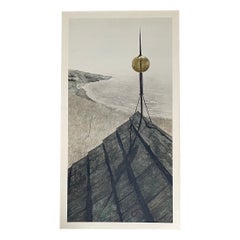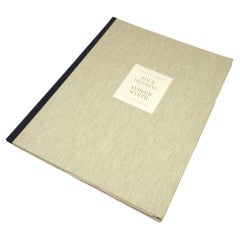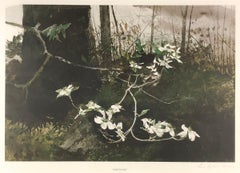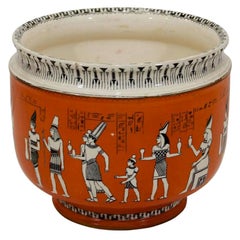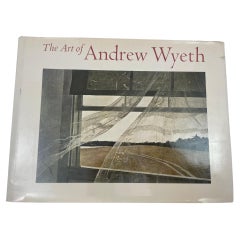Andrew Wyeth Furniture
American, 1917-2009
An artist who pursued his own course when the rest of the art world was consumed with modernism and abstraction, Wyeth is considered among the preeminent representational painters of the 20th century. Born in Chadds Ford, Pennsylvania, Wyeth drew his subject matter from the world around him: the interiors and exteriors of the stone buildings, mills, and farms of the Brandywine River countryside, and in the summers, the clapboard houses and stark landscape of the Maine coast. After his father died in a 1945 automobile accident, Wyeth began to incorporate people into his pictures, most notably Christina Olson, and later Siri Erickson, of Cushing, Maine, and his Chadds Ford neighbors Karl and Anna Kuerner and Helga Testorf. The first visual artist to appear on the cover of Time magazine, Wyeth was also the first living American-born artist to be given an exhibition at The Metropolitan Museum of Art in New York.
Wyeth’s naturalistic style is marked by strong editing combined with remarkable execution of details. While relying on keen visual observation, he pared down the elements of a composition to their most essential, giving his works an abstracted quality and imbuing them with a sense of quietude and stillness. The egg tempera medium (which he came to prefer to oil after first experimenting with it in the early 1940s) lent itself to the precise detailing required to create his subtle textural effects, since it dries quickly and translucent layers can be built up over one another. Wyeth also painted extensively in watercolor in works of more spontaneous execution, as well as in the drybrush technique (where most water is removed from the watercolor medium), sometimes combining the two.(Biography provided by Heather James Fine Art)
to
1
5
5
3
1
1
1
1976 Andrew Wyeth Canada Goose Collotype Metropolitan Museum of Art 34"
By Andrew Wyeth
Located in Dayton, OH
Vintage 1976 collotype on paper of "Canada" by Andrew Wyeth. Shows a Canada goose in a basket hanging from a hook in the ceiling of a stone cottage. Number 241 of a limited edition o...
Category
1970s Vintage Andrew Wyeth Furniture
Materials
Paper
"Nothern Point" Color Collotype Print by Andrew Wyeth
By Andrew Wyeth
Located in San Diego, CA
"Nothern Point" signed in print color collotype print by Andrew Wyeth, circa 1950s. The piece is in very good vintage condition and comes unframed mounted on board. This wonderful pi...
Category
20th Century American Andrew Wyeth Furniture
Materials
Wood
Royal Doulton Porcelain Bowl Designed by Andrew Wyeth England 1973
By Andrew Wyeth, Royal Doulton
Located in North Hollywood, CA
Vintage Royal Doulton Porcelain Bowl Designed by Andrew Wyeth England 1973.
Amazing Royal Doulton Andrew Wyeth large porcelain bowl with apple branches 13" Limited Ed.
Andrew Wyeth b...
Category
Late 20th Century English Victorian Andrew Wyeth Furniture
Materials
Porcelain
Four Seasons: Fine Prints from Paintings and Drawings by Andrew Wyeth Folio
By Andrew Wyeth
Located in Brooklyn, NY
The "Four Seasons: Fine Prints from Paintings and Drawings by Andrew Wyeth" is a portfolio of loose prints by Andrew Wyeth with an accompanying pamphlet in the set's original box. P...
Category
Mid-20th Century Andrew Wyeth Furniture
Materials
Paper
Dogwood
By Andrew Wyeth
Located in Missouri, MO
Andrew Wyeth
"Dogwood" 1983
Collotype
Ed. 115/300
Signed and Numbered Lower Right
Image Size: 21 x 28 3/4 inches
Framed Size: approx. 29 x 36.5 inches
A painter of landscape and figure subjects in Pennsylvania and Maine, Andrew Wyeth became one of the best-known American painters of the 20th century. His style is both realistic and abstract, and he works primarily in tempera and watercolor, often using the drybrush technique.
He is the son of Newell Convers and Carolyn Bockius Wyeth of Chadds Ford, Pennsylvania, and was home-schooled because of delicate health. His art instruction came from his famous-illustrator father, who preached the tying of painting to life--to mood and to essences and to capturing the subtleties of changing light and shadows.
The Wyeth household was a lively place with much intellectual and social stimulation. Because of the prominence of N.C. Wyeth, persons including many dignitaries came from all over the country to visit the family. Andrew's sisters Carolyn and Henriette became noted artists as did his brother-in-law, Peter Hurd. The non-art oriented brother, Nathaniel Wyeth...
Category
1980s American Modern Andrew Wyeth Furniture
Materials
Lithograph, Paper
Related Items
Royal Doulton Egyptian Revival Porcelain Jardinière
By Royal Doulton
Located in Stamford, CT
Royal Doulton jardinière made during the Egyptian Revival period.
Category
Early 20th Century English Egyptian Revival Andrew Wyeth Furniture
Materials
Porcelain
Ghidini 1961 Cestino 2 Large Bowl in Polished Brass by Andrea Branzi
By Andrea Branzi, Ghidini 1961
Located in Villa Carcina, IT
"The dance, intended as an eternal circle and sacred ritual and celebration of the ancient tribal traditions." This is the reference of Andrea Branzi when he thought of this series of three pieces that define these new vase...
Category
21st Century and Contemporary Italian Modern Andrew Wyeth Furniture
Materials
Brass
"Rupi" Sand Cast Bronze Bowl by Jaimal Odedra
By Jaimal Odedra
Located in New York, NY
"Rupi"
Bronze bowl by Jaimal Odedra. The "Rupi" bowls are made in five sizes, which may be used individually or as a set of nesting bowls. This is the third largest size out of fi...
Category
2010s Moroccan Andrew Wyeth Furniture
Materials
Bronze
Contemporary Black Copper Bai He Tray by Robert Kuo, Hand Repousse
By Robert Kuo
Located in Los Angeles, CA
Bai He tray
Black copper
Hand repoussé
Limited edition
Each piece is individually crafted and is unique.
Repoussé is the traditional art of hand-hammering decorative relief o...
Category
2010s Modern Andrew Wyeth Furniture
Materials
Copper
Vintage Italian Richard Ginori Porcelain Jewelry Dish, circa 1960s
By Richard Ginori
Located in New York, NY
A vintage Italian white porcelain dish or bowl with gold detail by designer Richard Ginori, circa mid-20th century, 1960s, Italy. Dish was probabl...
Category
1960s Italian Vintage Andrew Wyeth Furniture
Materials
Porcelain
Antique Map of West Canada by Tallis 'c.1850'
Located in Langweer, NL
Antique map titled 'West Canada'. Original antique map of West Canada, with decorative vignettes titled Kingston and Falls of Niagara. This map originates from 'The History and Topog...
Category
Mid-19th Century Antique Andrew Wyeth Furniture
Materials
Paper
Gateside Conversation, 1940s Original Signed Lithograph by Thomas Hart Benton
By Thomas Hart Benton
Located in Denver, CO
'Gateside Conversation' is an original signed lithograph by Thomas Hart Benton (1889-1975) from 1946. Singed by the artist in the lower right margin and titled verso. Portrays a figu...
Category
1940s American Modern Andrew Wyeth Furniture
Materials
Paper, Lithograph
Prodigal Son
By Thomas Hart Benton
Located in London, GB
A fine impression with full margins published by Associated American Artists with their information label present - pictured in Art and Popular Religion in Evangelical America, 1815-...
Category
1930s American Modern Andrew Wyeth Furniture
Materials
Lithograph
Ruins of Central City, Vintage 1935 Framed Colorado Modernist Landscape
By Vance Kirkland
Located in Denver, CO
Vintage lithograph titled "Ruins of Central City 31/70" is a modernist landscape with decaying buildings and mountains by Vance Hall Kirkland, from 1935. Presented in a custom black frame with archival materials, outer dimensions measure 25 ⅞ x 29 ⅜ x ⅝ inches. Image sight size is 14 x 17 ¾ inches.
Painting is clean and in very good vintage condition - please contact us for a detailed condition report.
Provenance: Private collection, Denver, Colorado
Expedited and international shipping is available - please contact us for a quote.
About the Artist:
Variously referred to as the "Father of Modern Colorado Painting", "Dean of Colorado Artists", and "Colorado’s pre-eminent artist," Kirkland was an inventive, visionary painter who spent fifty-two years of his fifty-four-year career in Denver. Of the approximately 1,200 paintings he created, about 550 from the first half of his career (1927-1953) are water-based media: acquarelle, gouache, casein and egg tempera, with a few oils. In the latter half of his career (1953-1981) he used oil and his unique oil and water mixture. He also produced five hundred drawings and some ten prints, mostly lithographs on stone, while also engaged in teaching full-time for most of the period.
To show people "something they have never seen before and new ways to look at things," he felt he needed to preserve his artistic freedom. Consequently, he chose to spend his entire professional career in Denver far removed from the established American art centers in the East and Midwest. "By minding my own business and working on my own," he said, "I think it was possible to develop in this part of the country… I’ve developed my kind of work [and] I think my paintings are stronger for having worked that way." The geographical isolation resulting from his choice to stay in Colorado did not impede his creativity, as it did other artists, but in fact contributed to his unique vision.
The son of a dentist, who was disappointed with his [son’s] choice of art as a career, Kirkland flunked freshman watercolor class in 1924 at the Cleveland School of Art (now the Cleveland Institute of Art) for putting colors into his landscapes that did not exist in nature and for competing colors. Not dissuaded, he won first prize for his watercolors in his junior and senior years. [While in Cleveland,] he studied with three influential teachers. Henry Keller, included in the prestigious New York Armory Show in 1913, introduced him to designed realism which he later used in his Colorado landscapes in the 1930s and 1940s. His other teachers were Bill Eastman, who studied with Hans Hofmann and appreciated all the new movements in modern art, and Frank Wilcox, a fine watercolorist.
While a student at the Cleveland School of Art, Kirkland concurrently took liberal arts courses at Western Reserve and the Cleveland School of Education and taught two freshman courses in watercolor and design, receiving his diploma in painting from the school in 1927 by doing four years of work in three. The following year he received a Bachelor of Education in Art degree from the same institution.
In 1929 he assumed the position of founding director of the University of Denver’s School of Art, originally known as the Chappell School of Art. He resigned three years later when the university reneged on its agreement to grant its art courses full recognition toward a Bachelor of Arts degree. His students prevailed on him to continue teaching, resulting in the Kirkland School of Art which he opened in 1932 at 1311 Pearl Street in Denver. The building, where he painted until his death in 1981, formerly was the studio of British-born artist, Henry Read, designer of the City of Denver Seal and one of the original thirteen charter members of the Artists’ Club of Denver, forerunner of the Denver Art Museum. The Kirkland School of Art prospered for the next fourteen years with its courses accredited by the University of Colorado Extension Center in Denver.
The teaching income from his art school and his painting commissions helped him survive the Great Depression. The U.S. Treasury Department’s Section of Fine Arts commissioned from him two post office murals, Cattle Roundup (1938, Eureka, Kansas), and Land Rush (1940, Sayre, Oklahoma). He also did murals for several Denver clients: the Gerald Hughes mansion (1936, later demolished), Arthur Johnson home (1936-37, Seven Drinks of Man), Albany Hotel (1937, later demolished), Neustetter’s Department Store (1937, "History of Costume," three of five saved in 1987 before the building interior was demolished in advance of its condo conversion), and the Denver Country Club (1945, partially destroyed and later painted over).
In 1953 the Ford Times, published by the Ford Motor Company, commissioned Kirkland along with fellow Denver artists, William Sanderson and Richard Sorby, to paint six watercolors each for the publication. Their work appeared in articles [about] Colorado entitled, "Take to the High Road" (of the Colorado Rockies) by Alicita and Warren Hamilton. Kirkland sketched the mountain passes and high roads in the area of Mount Evans, Independence Pass near Aspen, and Trail Ridge Road in Rocky Mountain National Park.
In 1946 Kirkland closed his art school when the University of Denver rehired him as director of its School of Art and chairman of the Division of Arts and Humanities. In 1957 the University gave him its highest honor – the "University Lecturer Award." When he retired in 1969 as Professor of Art Emeritus to become a full-time painter, the School of Arts was the university’s largest undergraduate department. In 1971 Governor John Love presented Kirkland the State of Colorado Arts and Humanities Award. In addition to his dual positions as artist and teacher in Denver for more than half a century, he served the Denver Art Museum as a trustee, chairman of the accessions committee, member of the exhibitions committee, curator of European and American art, and honorary curator of painting and sculpture. He also won the battle with the museum’s old guard to establish a department of modern and contemporary art. Additionally, he was one of the fifty-two founding members of the Denver Artists Guild which included most of Colorado’s leading artists who greatly contributed to the state’s cultural history.
Kirkland developed five major painting periods during his life encompassing various series with some chronological overlap: Designed Realism (1927-1944); Surrealism (1939-1954); Hard Edge Abstraction, including the Timberline Abstraction Series (1947-1957); Abstract Expressionism with four series – Nebulae, Roman, Asian, and Pure Abstractions (1951-1964); and the Dot Paintings with five series – Energy of Vibrations, Mysteries, Explosions, Forces, and Pure Abstractions (1963-1981).
Nevadaville (1931), a watercolor, belongs to Kirkland’s initial period of Designed Realism. Adapting nature by redesigning the realism he saw on location in Colorado allowed him to be "more concerned with the importance of the painting rather than the importance of the landscape." He noted that the rhythms his Cleveland teacher, Henry Keller, "found in nature created a certain movement in his paintings… [that moved] away from the static element of a lot of realistic, representational painting." Kirkland, along with fellow watercolorist Elisabeth Spalding, were some of the first Denver artists interesting themselves in Colorado’s nineteenth-century mining towns west of Denver. They offered an alternative to the overwrought cowboy and Indian subject matter of the previous generation; while the human and architectural components of the mining towns provided a welcome break from the predominant nineteenth-century landscape tradition.
Vibrations of Two Yellows in Space (1970), one of Kirkland’s small subseries of "Open Sun Paintings," occupies the final phase in his first series of dot paintings, Energy of Vibrations in Space (1963-1972). Many pieces in the series incorporate his unique mixture of oil paint and water which he developed in the early 1950s. The work in the subseries – a challenge to the viewer’s optic nerve – constitutes his contribution to the international realm of Op Art. Recalling the theory of pulsating galaxies and the universe, he used dots applied with dowels of different sizes to surround and leave round open spaces letting the gradient background show through. Because of the color contrast between the two, the "suns" either recede into the background or jump out in the foreground, creating the powerful pulsing effect.
During his lifetime he assembled on a limited budget an extensive collection of fine and decorative art and furniture. His collecting passion dated from his student days when he used his prize money from the Cleveland School of Art to purchase a watercolor by William Eastman and a now-famous set of Russian musician figures by Alexander Blazys, both of whom were his professors. After Kirkland’s death, the Denver Art Museum received a large bequest that included paintings by Roberto Matta, Gene Davis, Charles Burchfield, and Richard Anuszkiewicz (the two latter-named also alumni of the Cleveland Institute of Art); prints by Arthur B. Davies, Roberto Matta, Pablo Picasso, and Robert Rauschenberg; and a sculpture by Ossip Zadkine.
Kirkland posthumously was the subject of a television documentary, "Vance Kirkland’s Visual Language," aired on over one hundred PBS television stations (1994-96), and in 1999 a six-scene biographical ballet choreographed by Martin Friedmann with scenario provided by Hugh Grant, founder and director of the Kirkland Museum of Fine & Decorative Art in Denver. Historic Denver also posthumously honored Kirkland as part of the Colorado 100.
From 1997 to 2000 Kirkland’s solo exhibition was hosted by thirteen European museums: Fondazione Muduma, Milan; Sala Parpalló Museum Complex, València; Stadtmuseum, Düsseldorf; Frankfurter Kunstverein; Museum of Modern Art, Vienna; Kiscelli Múzeum and the Museum of Fine Arts, Budapest; Czech Museum of Fine Arts, Prague; National Museum, Warsaw; State Gallery of the Art of Poland, Sopot/Gdańsk, National Museum of Art, Kaunas, Lithuania; Latvian Foreign Art Museum, Riga; and the State Russian Museum, St. Petersburg.
Solo Exhibitions: Denver Art Museum (1930, 1935, 1939-40, 1942, 1972, 1978-retrospective, 1988, 1998); Colorado Springs Fine Arts Center (1943); Knoedler & Company, New York (1946, 1948, 1952); Pogzeba Art Gallery, Denver (1959); Galleria Schneider, Rome (1960); Birger Sandzén Memorial Gallery, Lindsborg, Kansas (1964-65,1977); Genesis Galleries, Ltd., New York (1978); Valhalla Gallery, Wichita, Kansas (1979); Inkfish Gallery, Denver (1980); Colorado State University, Fort Collins (1981- memorial exhibition); Boulder Center for the Visual Arts (1985); University of Denver, Schwayder Art Gallery (1991).
Group Exhibitions (selected): "May Show," Cleveland Museum of Art (1927-28); "Western Annuals," Denver Art Museum (1929-1957, 1964, 1966, 1968, 1971); "International Exhibition of Watercolors, Pastels, Drawings and Monotypes," Art Institute of Chicago (1930-1946); "Abstract and Surrealist American Art," Art Institute of Chicago (1947-48, traveled to ten other American museums); "Midwest Artists Exhibition," Kansas City Art Institute (1932, 1937, 1939-1942); Dallas Museum of Art (1933, 1960); San Diego Museum of Art (1941); "Artists for Victory," Metropolitan Museum of Art (1942); "United Nations Artists in America," Argent Galleries, New York (1943); "California Watercolor Society," Los Angeles County Museum (1943-1945); "Survey of Romantic Painting," Museum of Modern Art, New York (1945); New Mexico Museum of Art, Santa Fe (1945, 1951); Knoedler & Company, New York (1946-57; co-show with Max Ernest, 1950; co-show with Bernard Buffet, 1952); Joslyn Art Museum, Omaha (1948, 1956); Philbrook Art Center, Tulsa, Oklahoma (1951); "Contemporary American Painting," University of Illinois, Urbana (1952); University of Utah, Salt Lake (1952-53); Oakland Art Museum (1954-55); "Reality and Fantasy, 1900-54," Walker Art Center, Minneapolis (1954); "Art U.S.A.," Madison Square Garden, New York (1958); Roswell Museum and Art Center, New Mexico (1961); Burpee Art Museum, Rockford, Illinois (1965-68); University of Arizona Art...
Category
1930s American Modern Andrew Wyeth Furniture
Materials
Paper, Lithograph
H 25.75 in W 29.5 in D 0.5 in
Nebraska Evening
By Thomas Hart Benton
Located in London, GB
A fine impression with good margins published by Associated American Artists.
Category
1940s American Modern Andrew Wyeth Furniture
Materials
Lithograph
"Rupi" Sand Cast Bronze Bowl by Jaimal Odedra
By Jaimal Odedra
Located in New York, NY
"Rupi"
Bronze bowl by Jaimal Odedra. The "Rupi" bowls are made in five sizes, which may be used individually or as a set of nesting bowls. This is the third largest size out of five...
Category
2010s Moroccan Andrew Wyeth Furniture
Materials
Bronze
Largest "Rupi, " Sand Cast Bronze Bowl by Jaimal Odedra
By Jaimal Odedra
Located in New York, NY
"Rupi"
Bronze bowl by Jaimal Odedra. The "Rupi" bowls are made in five sizes, which may be used individually or as a set of nesting bowls. This is the largest size out of five.
...
Category
2010s Moroccan Andrew Wyeth Furniture
Materials
Bronze
Previously Available Items
The Art of Andrew Wyeth by Corn, Wanda M by Corn, Wanda M Hardcover 1st Ed. 1973
By Andrew Wyeth
Located in North Hollywood, CA
The Art of Andrew Wyeth by Wanda M. Corn hardcover book.
Published by The Fine Arts Museum of San Francisco.
First printing. First Edition: 197...
Category
Late 20th Century American Expressionist Andrew Wyeth Furniture
Materials
Paper
H 9.5 in W 12 in D 1 in
Four Seasons: Fine Prints from Paintings and Drawings by Andrew Wyeth Folio
By Andrew Wyeth
Located in Brooklyn, NY
The "Four Seasons: Fine Prints from Paintings and Drawings by Andrew Wyeth" is a portfolio of loose prints by Andrew Wyeth with an accompanying pamphlet in the set's original box. P...
Category
Mid-20th Century Andrew Wyeth Furniture
Materials
Paper
April Wind Lithograph by Andrew Wyeth
By Andrew Wyeth
Located in Los Angeles, CA
Framed lithograph of Andrew Wyeth's 1952 work, April Wind.
Dimensions
32” width x 26” height and extends 1.5” from the wall.
Condition
Good vintage condition; professionally clea...
Category
1950s American Mid-Century Modern Vintage Andrew Wyeth Furniture
Materials
Wood, Paper
Split Ash Basket, Karl's Room, The Scarecrow, The Fortune, Shed Lantern, Bundle
By Andrew Wyeth
Located in Clinton Township, MI
Bulk Sale of nine posters
Dimensions for packaging: two tubes measuring 43 in x 4 in - two shipping labels needed (1/1 and 1/2)
Category
20th Century Andrew Wyeth Furniture
Materials
Lithograph
Andrew Wyeth "Christina's World" Framed Collotype Print 1976 Limited Edition
By Andrew Wyeth
Located in Dayton, OH
“Christina’s World – Study, 1948” by Andrew Wyeth. Professionally framed. From a portfolio of 10 facsimile collotype prints of drawings by Andrew Wyet...
Category
1970s American Classical Vintage Andrew Wyeth Furniture
Materials
Paper
H 31 in W 1 in D 33.5 in
Andrew Wyeth "The Keurners" Framed Collotype Portrait Print 1976 Limited Edition
By Andrew Wyeth
Located in Dayton, OH
"“The Kuerners – study, 1971” by Andrew Wyeth. Professionally framed. From a portfolio of 10 facsimile collotype prints of drawings by Andrew Wyeth. Produced by The Metropolitan Muse...
Category
1970s American Classical Vintage Andrew Wyeth Furniture
Materials
Paper
H 38.5 in W 1 in D 41.25 in
Andrew Wyeth "Evening at Kuerners" Landscape Framed Collotype Print Lim Ed 1976
By Andrew Wyeth
Located in Dayton, OH
“Evening at Kuerners – Study, 1970” by Andrew Wyeth. Professionally framed. From a portfolio of 10 facsimile collotype prints of drawings produced by The Metropolitan Museum of Art, ...
Category
1970s American Classical Vintage Andrew Wyeth Furniture
Materials
Paper
H 34.5 in W 1 in D 38 in
Andrew Wyeth Collotype Print Spring Fed Cows 1976 Metropolitan Museum
By Andrew Wyeth
Located in Dayton, OH
Spring Fed – Study, 1967” by Andrew Wyeth. From a portfolio of 10 facsimile collotype prints of drawings by Andrew Wyeth. Produced by The Metropolitan Museum of Art, 1976. The portfo...
Category
1970s American Classical Vintage Andrew Wyeth Furniture
Materials
Paper
Andrew Wyeth Collotype Print Snow Flurries Landscape 1976 Metropolitan Museum 24
By Andrew Wyeth
Located in Dayton, OH
“Snow Flurries – Study 1953” by Andrew Wyeth. From a portfolio of 10 facsimile collotype prints of drawings by Andrew Wyeth. Produced by The Metropolitan Museum of Art, 1976. The por...
Category
1970s American Classical Vintage Andrew Wyeth Furniture
Materials
Paper
H 16.25 in W 0.125 in D 23.75 in
Andrew Wyeth Collotype Print New England 1976 Metropolitan Museum
By Andrew Wyeth
Located in Dayton, OH
“New England – Study, 1960” by Andrew Wyeth. From a portfolio of 10 facsimile collotype prints of drawings by Andrew Wyeth. Produced by The Metropolitan Museum of Art, 1976. The port...
Category
1970s American Classical Vintage Andrew Wyeth Furniture
Materials
Paper
Andrew Wyeth Collotype Print Spring Fed Kitchen Sink 1976 Metropolitan Museum 20
By Andrew Wyeth
Located in Dayton, OH
“Spring Fed – Study, 1967” by Andrew Wyeth. From a portfolio of 10 facsimile collotype prints of drawings by Andrew Wyeth. Produced by The Metropolitan Museum of Art, 1976. The portf...
Category
1970s American Classical Vintage Andrew Wyeth Furniture
Materials
Paper
H 24.75 in W 0.125 in D 31.5 in
Andrew Wyeth Collotype Print My Young Friend Portrait 1976 Metropolitan Museum 2
By Andrew Wyeth
Located in Dayton, OH
My Young Friend – Study, 1970” by Andrew Wyeth. From a portfolio of 10 facsimile collotype prints of drawings by Andrew Wyeth. Produced by The Metropolitan Museum of Art, 1976. The p...
Category
1970s American Classical Vintage Andrew Wyeth Furniture
Materials
Paper
H 17 in W 0.125 in D 19.75 in
Andrew Wyeth furniture for sale on 1stDibs.
Andrew Wyeth furniture are available for sale on 1stDibs. These distinctive items are frequently made of wood and are designed with extraordinary care. There are many options to choose from in our collection of Andrew Wyeth furniture, although gray editions of this piece are particularly popular. Many of the original furniture by Andrew Wyeth were created in the Victorian style in united states during the 20th century. If you’re looking for additional options, many customers also consider furniture by Adderley Ware, John Taylor, Powell, and Bishop & Stonier. Prices for Andrew Wyeth furniture can differ depending upon size, time period and other attributes — on 1stDibs, these items begin at $275 and can go as high as $850, while a piece like these, on average, fetch $650.
Creators Similar to Andrew Wyeth
Questions About Andrew Wyeth Furniture
- 1stDibs ExpertFebruary 22, 2021An Andrew Wyeth painting can be worth anywhere from $200 to over $80 million. 1stDibs.com sells a number of paintings from Andrew Wyeth.

